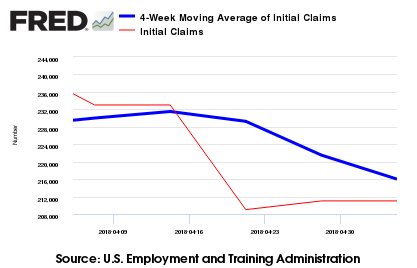Blue Line 4 Week Average

The market was expecting the weekly intiall unemployment claims at 300,000 to 340,000 (consensus 309,000) vs the 317,000 reported. The more important (because of the volatility in the weekly reported claims and seasonality errors in adjusting the data) 4 week moving average moved from 310,500 (reported last week as 310,250) to 315,250.
It should be pointed out that Econintersect watches the year-over-year change on the 4 week moving average. There is always some seasonality which migrates into the seasonally adjusted data, and year-over-year comparisons helps remove some seasonality. The four week rolling average of initial claims are 8.8% lower (worse than the 12.0% reported last week) than they were in this same week in 2013 (see chart below).

2014 claim levels are now within the normal range (around 350,000 weekly initial unemployment claims) of levels seen historically during times of economic expansion (see chart below).

From the Department of Labor:
In the week ending June 7, the advance figure for seasonally adjusted initial claims was 317,000, an increase of 4,000 from the previous week’s revised level. The previous week’s level was revised up by 1,000 from 312,000 to 313,000. The 4-week moving average was 315,250, an increase of 4,750 from the previous week’s revised average. The previous week’s average was revised up by 250 from 310,250 to 310,500. There were no special factors impacting this week’s initial claims.
The advance seasonally adjusted insured unemployment rate was 2.0 percent for the week ending May 31, unchanged from the previous week’s unrevised rate. The advance number for seasonally adjusted insured unemployment during the week ending May 31 was 2,614,000, an increase of 11,000 from the previous week’s unrevised level of 2,603,000. The 4- week moving average was 2,622,000, a decrease of 13,000 from the previous week’s unrevised average of 2,635,000. This is the lowest level for this average since November 24, 2007 when it was 2,616,750.

